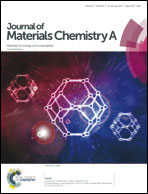Controlled self-assembly of Ni foam supported poly(ethyleneimine)/reduced graphene oxide three-dimensional composite electrodes with remarkable synergistic effects for efficient oxygen evolution†
Abstract
Three-dimensional (3-D) composite oxygen evolution electrodes with synergistic effects are promising to significantly boost the efficiency of the oxygen evolution reaction (OER). However, their fabrication presents great challenges. Herein, for the first time we show that layer-by-layer (LbL) self-assembly on 3-D substrates can be employed to controllably fabricate 3-D composite electrodes. Ni foam (NF) supported poly(ethyleneimine) (PEI)/reduced graphene oxide (RGO) multilayers fabricated via this approach have tunable catalytic properties. The optimum one achieves the current density of 10 mA cm−2 at an overpotential of 322 mV, which is lower than those of most reported transition metal-based OER catalysts and non-metal ones as well as those of state-of-the-art Ir/C, Ru/C, IrO2/C, and RuO2 measured under the same conditions (0.1 M KOH). It shows a Tafel slope of 78 mV dec−1, which is among the lowest reported for transition metal-based OER catalysts and non-metal ones and comparable to or even lower than that of state-of-the-art Ir and Ru-based ones measured in 0.1 M KOH. In addition, this electrode exhibits a potential increase from 0.55 V to 0.58 V vs. SCE after 18.8 h of chronopotentiometry testing at 10 mA cm−2 and retains 85.8% of the current density at 1.0 V vs. SCE after 350 CV cycles, revealing its good stability. The high catalytic performance could be attributed to in situ formed Ni(OH)2 with RGO-promoted activity, high-density C![[double bond, length as m-dash]](https://www.rsc.org/images/entities/char_e001.gif) O rich edge-exposed RGO nanosheets, and the covalently crosslinked multilayer structure of chemically stable RGO nanosheets. All of these properties arise from synergistic interactions between NF, PEI, and RGO. This work offers a facile, mild, controllable, and economical strategy to synergistically assemble conventional poor OER catalysts for low-cost, highly active, and durable 3-D OER electrodes. It also provides scientific insight into the mechanism for the superior and tunable OER catalytic activity, which is critical for further improving the OER catalytic performance.
O rich edge-exposed RGO nanosheets, and the covalently crosslinked multilayer structure of chemically stable RGO nanosheets. All of these properties arise from synergistic interactions between NF, PEI, and RGO. This work offers a facile, mild, controllable, and economical strategy to synergistically assemble conventional poor OER catalysts for low-cost, highly active, and durable 3-D OER electrodes. It also provides scientific insight into the mechanism for the superior and tunable OER catalytic activity, which is critical for further improving the OER catalytic performance.



 Please wait while we load your content...
Please wait while we load your content...